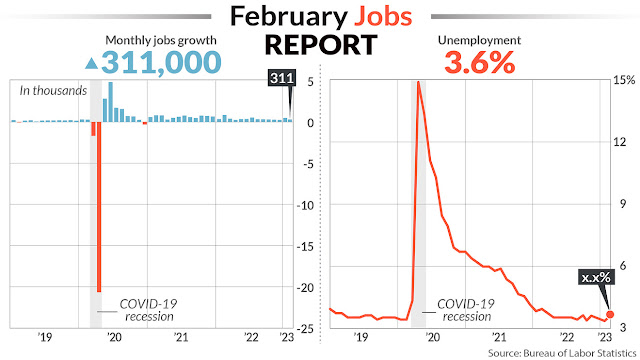Employers added 311,000 jobs in February, the Labor Department reported Friday, continuing a hotter-than-anticipated streak that has created abundant opportunities for job seekers while frustrating the Federal Reserve in its drive to contain stubborn inflation.
The unemployment rate ticked up to 3.6 percent, still, an exceptionally low level brought about both by robust job creation and workers’ slow return to the labor force after the pandemic.
The job market has remained a persistent source of dynamism in the economy even as other elements have either lost their steam or yielded to higher interest rates.
“Some of these sectors, especially services, are still recovering from the pandemic, said Eugenio Alemán, chief economist at the financial services firm Raymond James. “I think that puts the thought of a recession kind of in doubt.”
The fresh data add to a cacophonous landscape of economic indicators, some of which suggest that businesses and consumers are ramping back up after absorbing the Federal Reserve’s largest interest rate increases in 2022. Others, like the share of workers quitting their jobs, continue to sink back to earth after extraordinary surges over the past three years.
This batch of information on the state of the labor market will be the last to inform the Federal Reserve before it makes its next interest rate decision in two weeks. It had been expected to stick to a slower course, with increases of one-quarter of a percentage point, but Jerome H. Powell, the Fed chair, warned this week that the outlook could change if new data showed that the economy wasn’t slowing enough to keep inflation in check.
To date, acute labor shortages in some fields have made employers extremely reluctant to shed workers even as the business has faded in some industries, especially manufacturing. But that forbearance may wear thin if the Fed also succeeds in slowing demand for services, where millions of unfilled jobs have propelled wage growth.
The US population-to-employment ratio and participation rate for prime-age workers, those aged 25-54, increased for the first time to levels seen prior to the pandemic. This is an important indicator because it signals a key, productive demographic contributing to the labor market.
BREAKING: The US added 311,000 jobs in February, far outpacing the 225,000 estimated https://t.co/wEBa7oQ28a pic.twitter.com/WuRi8VDA2R
— Bloomberg TV (@BloombergTV) March 10, 2023
BREAKING: The U.S. added 311,000 jobs in February, more than expected. https://t.co/kluQV85ZKO pic.twitter.com/AWSiqoVkv5
— CNBC (@CNBC) March 10, 2023
BREAKING NEWS: US job growth surges again in February as economy adds 311,000 new positionshttps://t.co/ox5BQaTfWw
— FOX Business (@FoxBusiness) March 10, 2023
The best news in the job report? More people are looking for work.
— Heather Long (@byHeatherLong) March 10, 2023
419,000 people entered the labor force in February.
The unemployment rate went up b/c more people are looking for jobs, not b/c of layoffs.
This is good news. More workers are returning. pic.twitter.com/yphqeu1WCA






.png)
